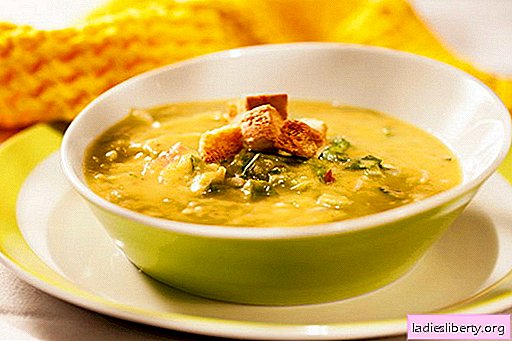
Marmalade is one of the most useful delicacies in the world, which should not be abandoned even to those who follow the figure. And in order to choose among the marmalade variety the best - it is useful to know everything about it and a little more.
How the composition determines the benefits of marmalade and why this sweet is better than others
The homeland of modern marmalade can be considered France of the 17th century, the confectioners of which reached unprecedented heights in an effort to please the King of the Sun - gelling substances that added yesterday’s pastille (which was prepared to preserve the harvest as early as Ancient Greece) radiant translucency and elastic silky texture.
But the real flowering of the assortment of marmalade can be observed today.
Marmalade is used as an independent delicacy, used to decorate cakes and milkshakes, add it to pastries, cottage cheese casseroles and other dessert dishes.
It is noteworthy that if you take a jar with the name "marmalade" in a US store, then it will surely reveal a product resembling thick, jelly-like jam (very tasty, by the way, on toast with cheese), and their dense (candy) marmalade is called differently.
Despite the fact that some fruits, for example apples, contain quite a lot of substances that can form a characteristic, thick, dense and elastic consistency of the product, marmalade preparation technologies in most cases include the mandatory use of one of the following gelling substances:
• gelatin;
• pectin;
• agar-agar or carrageenan.
The benefits of all these substances in the composition of marmalade are approximately equivalent:
• marmalade for a long time creates a feeling of satiety, and if you eat it before something satisfying, you can even kill the appetite, that is, it is beneficial to reduce the portion;
• for the same reason, marmalade should be left on the menu when dieting - a few pieces of it will allow you to distract from thoughts about food or come to terms with green salad instead of cutlets;
• Once in the intestine, gelling components participate in the formation of the environment for reproduction and activity of beneficial microflora;
• in the gastrointestinal tract, these substances act as absorbents for undigested food debris, toxins and toxins, which are rapidly excreted due to the gentle increase in intestinal motility (and agar-agar is especially good in this).
In connection with the last property, marmalade is often recommended during the recovery period after food poisoning.
Carrageenan and agar-agar obtained from red algae are a source of iodine for humans, indispensable for the health of the thyroid gland.
Gelatin obtained from bones and other low-value carcass remains of cattle is valuable as a source of collagen necessary for healthy joints and youthful skin.
The classification of marmalade varieties is diverse and often confusing, but in general, they can be divided into:
• reservoir - prepared from heavily boiled fruit and berry puree with the addition of a small amount of pectin. The final product is simple - it resembles a layer of frozen jam and does not differ in tenderness;
• jelly - has a characteristic marmalade consistency, it is often prepared from juices and syrups (with a minimum of mashed potatoes) with the addition of any gelling substances and many other additives, it is it that is produced attractively bright, often shaped in sugar, in the form of lemon slices and in many others options;
• chewing is similar to jelly, but has a long-lasting density, in 99% of cases it contains gelatin.
The energy value of marmalade varies from about 200 to 400 kcal - enough for those who count calories and those who aim to put on weight.
In any quality (that is, as natural as possible) marmalade, vitamins, natural sugars, organic acids, flavonoids, pigments and minerals are in excess, and fiber and essential oils can often be found in it.
And all together it develops into some of the most striking useful properties of marmalade:
• rapid healing of wounds and burns, the formation of new skin not marked with rough scars and scars;
• normalization of the urinary system;
• cleansing blood vessels of cholesterol and increasing their tone, strength and elasticity;
• improvement of the condition of hair (stronger, lush, shiny, docile) and nails (not brittle, resistant to pathogens of fungal diseases).
Other options for manifesting the benefits of marmalade
For disorders in the nervous system, with which many people are familiar in everyday life (including mood swings, fatigue, lethargy and irritability), it is useful not only to eat sweets, but, as scientists have proved, to chew. Leisurely and for a long time.
Therefore, chewing marmalade brings double benefits and can even be used to increase concentration and performance.
Sweet marmalade contains fast (complex) carbohydrates, so a snack allows them to quickly recharge with vital energy, restore strength after physical or mental labor.
Chewing marmalade is useful for the oral cavity - it is no worse than chewing gum capable of removing food particles, plaque from the teeth, and a component such as beeswax (which allows chewing marmalades for a long time, enjoying their dense consistency) disinfects the oral cavity up to the destruction of caries pathogens.
How does the benefit of marmalade differ depending on its taste-determining components
Speaking about the benefits of marmalade, it cannot be squeezed into the framework - a lot depends on its specific ingredients. After all, every fruit, berry, and even a vegetable and anything else that may be in marmalade, has special properties. Knowledge of which can be very useful.
• orange improves immunity, improves jointing of fractures, slows down the aging process and helps normalize blood pressure;
• coffee removes drowsiness and improves blood circulation in the brain;
• lemon slows down the aging process in the body, reduces the manifestations of malaise (nausea) with toxicosis and movement in transport;
• Blueberry protects the retina from degenerative processes and improves twilight vision;
• cherry prevents the development of gout and reduces allergic reactions of various origins;
• strawberry normalizes the production of digestive enzymes and improves the transportation of macro- and microelements to internal organs;
• apple prevents tumors and accelerates carbohydrate metabolism;
• lingonberry acts as an antiseptic, accelerating recovery in acute respiratory infections, while reducing pain and swelling in the throat and helps maintain normal body temperature;
• wine is useful for blood formation, supports the heart during intense physical exertion;
• pumpkin ensures the normal absorption of iron from any products and positively affects the adaptation of the body to changes in ambient temperature.
How is the harm of marmalade
In general, the very useful sweetness of marmalade can also cause considerable harm if the manufacturer filled it with synthetic components, which include some dyes, flavorings, stabilizers, flavorings, preservatives, and the like.
The influence of many such additives on the human body has not yet been fully studied, and what is known confirms their negative impact on the immune system, the functions of internal organs, nervous system, blood formation, skin condition ...
In a word, the store should focus not only on the appetizing look of marmalade, but also on its composition - the less artificial there is, the better.
But it’s not useful to get carried away with even the highest quality marmalade - this is fraught with:
• nausea;
• loss of appetite;
• increased difficultly quenched thirst;
• skin rashes.
And if overeating marmalade becomes a habit, then episodic, soon disappearing troubles can be added:
• weight gain;
• difficulties with the digestibility of food;
• deterioration of the pancreas;
• destruction of tooth enamel and increase its sensitivity;
• Frequent increase in blood sugar levels above normal.
With pancreatitis, in order to avoid harm from marmalade, treat them to a minimum, and the one that you can eat should be cooked on fructose.
And the same sweetener in sweets will allow you to use marmalade without harm in diabetes mellitus (but its taste from this will be no worse).











